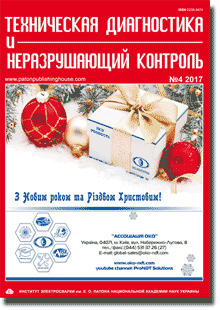| 2017 №04 (02) |
DOI of Article 10.15407/tdnk2017.04.03 |
2017 №04 (04) |

Technical Diagnostics and Non-Destructive Testing, №4, 2017 pp. 14-24
Idevelopment of procedure for determination of wall thickness in NPP pipeline at erosion-corrosion wear of material
I. V. Orynyak, A. Ya. KrasovSkiy, V. M. Borodiy, S. M. Ageev
S. Pisarenko Institute for Problems of Strength of the NAS of Ukraine, 2 Timiryazevska str., Kyiv-14, 01014. E-mail: info@ipp.kiev.ua
Developed are the methods for assessment of residual strength of pipeline elements (straight pipe and T-shaped tee joints) with flaws that are based on a static law of boundary loading in plasticity theory. In order to verify the correctness of proposed methods a series of full-scale tests were carried out up to failure of pipeline elements with surface cuts. The procedure agreed with the design norms was proposed to Ukrainian NPP for determination of allowable thickness of pipeline elements from carbon steels that were damaged by erosion-corrosion wear. 11 Ref., 3 Tabl., 10 Fig.
Keywords: pipeline; flaw; erosion-corrosion wear, boundary loading of ductile fracture
References
- Taranenko, V.I., Gashenko, V.A., Bakirov, M.B. et al. (2001) Influence of chemical elements-impurities in carbon- and silicon-manganese steels on service life characteristics of NPP pipings in erosion-corrosion wear. Teploenergetika, 12, 37-40 [in Russian].
- Baranenko, V.I., Yanchenko, Yu.A. (2008) Erosion-corrosion wear of elements of piping systems of NPP. Ibid., 5, 27-35 [in Russian].
- Taranenko, V.I., Markochev, V.M., Olejnik, S.G. et al. (2004) Accounting of erosion-corrosion wear in operation of NPP piping. Ibid., 8, 34-38 [in Russian].
- API RP 579. (2000) Recommended practice for fitness for service. American Petroleum Institute.
- (1999) Structural integrity assessment procedures for European industry: SINTAP. Final Version, 25-30.
- PNAE G-7-002-86. (1989) Strength standards of equipment and piping of nuclear power plants. Gosatomenergonadzor SSSR. Moscow, Energoatomizdat [in Russian].
- Kiefner, J.F., Maxey, W.A., Eiber, R.J., Duffy, A.R. (1973) Failyre stress levels of flaws in pressurized cylinders. Progress in flaw growth and fracture toughness testing. ASTM STP 536, 461-481.
- Orynyak, I.V. (2007) Leak and break models of pressurized pipe with axial defects. In: Proc. of the Biennial Intern. Pipeline Conf., IPC 3 PART A, pp. 41-56.
- Kanninen, M.F., Zahoor, A., Wilkowski, G. et al. (1982) Instability predictions for circumferentially cracked type-304 stainless steel pipes under dynamic loading. EPRI NP-2347, Electric Power Recearch Institute, Palo Alto, CA.
- Orynyak, I.V., Ageev, S.M. (2009) Simulation of limiting state of thick-wall pipes with axial surface defects. Problemy Mashinostr. i Nadyozhnosti Mashin, 4, 115-123.
- Orynyak, I.V., Ageev, S.M. (2010) Calculation of ?ref for transverse defects of complex shape in pipes. Mashynoznavstvo, 7, 3-11.
